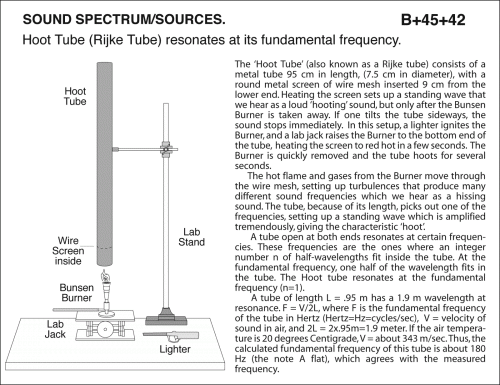Hoot Tube
Primary tabs
Hoot Tube (Rijke Tube) resonates at its fundamental frequency. The 'Hoot Tube' (also known as a Rijke tube) consists of a metal tube 95 cm in length, (7.5 cm in diameter), with a round metal screen of wire mesh inserted 9 cm from the lower end. Heating the screen sets up a standing wave that we hear as a loud 'hooting' sound, but only after the Bunsen Burner is taken away. If one tilts the tube sideways, the sound stops immediately. In this setup, a lighter ignites the Burner, and a lab jack raises the burner to the bottom end of the tube, heating the screen to red hot in a few seconds. The burner is quickly removed and the tube hoots for several seconds. THe hot flame and gases from the burner move through the wire mesh, setting up turbulence that produce many different sound frequencies, which we hear as a hissing sound. The tube, because of its length, pick out one of the frequencies, setting up a standing wave which is amplified tremendously, giving the characteristic 'hoot'. A tube open at both ends resonates at certain frequencies. These frequencies are the ones where an integer number n of half-wavelengths fit inside the tube. At the fundamental frequency one half of the wavelength fits in the tube. The Hoot Tube resonates at the fundamental frequency (n=1). A tube of length L = .95 m has a 1.9 m wavelength at resonance. F=V/2L, where F is the fundamental frequency of the tube in Hertz (Hertz=Hz=cycles/second), V = velocity of sound in air, and 2L = 2x.95=1.9 meter. If the air temperature is 20 degrees Centigrade, V = about 343 m/sec. Thus, the calculated fundamental frequency of this tube is about 180 Hz (the note A flat), which agrees with the measured frequency.
UCB Index:
B+45+42
PIRA Index:
3D30.70
UCB Taxonomy:
PIRA Taxonomy:
Popularity:
- Log in to post comments

